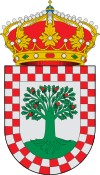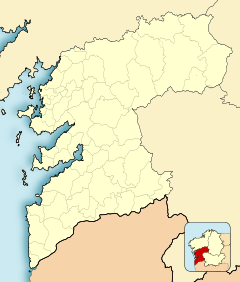A Cañiza facts for kids
Quick facts for kids
A Cañiza
|
|||
|---|---|---|---|
| Concello de A Cañiza | |||
 |
|||
|
|||
| Country | |||
| Autonomous community | |||
| Province | Pontevedra | ||
| Comarca | A Paradanta | ||
| Area | |||
| • Total | 108.1 km2 (41.7 sq mi) | ||
| Population
(2018)
|
|||
| • Total | 5,173 | ||
| • Density | 47.854/km2 (123.94/sq mi) | ||
| (INE) | |||
| Time zone | UTC+1 (CET) | ||
| • Summer (DST) | UTC+2 (CET) | ||
A Cañiza is a small town, also called a municipality, located in Galicia, Spain. It's part of the Pontevedra province and belongs to the comarca (a type of region) called A Paradanta. A Cañiza covers an area of about 108 square kilometers. In 2018, nearly 5,200 people lived there, spread across 9 smaller areas called parishes.
This village is known for its great tourism. It also has a growing industrial and business area. The local food is delicious, especially dishes made with ham. A Cañiza hosts important events like the ancient A Franqueira pilgrimages. These are big festivals recognized by Galicia as important for tourists. The famous Ham Fair is another popular event.
A Cañiza is in a mid-mountain area. This means you can see many different landscapes. There are mountains and valleys, showing a varied natural beauty. You can also learn about its history and art. Visitors can enjoy the local customs and many fun events all year. The town offers services to make life better for its people. It also meets the needs of travelers who visit A Cañiza every day.
Contents
A Cañiza: A Town's Story
A Cañiza is the newest of the nine parishes that make up the municipality. But today, it is the most important one. It is the capital of the municipality. Most government services are found here. It also has the largest population, even though it is the smallest in size. The history of this place goes back almost 200 years.
How A Cañiza Began
The first people to live in this parish came from nearby areas, especially Valeixe. They started settling in a place now called A Calzada. This was to be closer to their farms and fields. More and more neighbors wanted to live near their land. So, they began to build their own homes.
The name "Cañizas" was given to the parish. It perfectly explains how it started. The area became filled with small huts. These huts were made of woven tree branches. They were covered with straw. Local people called these huts "Cañizas" or "hurdles." Farmers used them to shelter from the rain. These hurdles were also known as granaries.
The Royal Road and Growth
Later, a "Royal Road" was built. This road connected the cities of Tuy and Vigo to Castile. This project gave a big boost to the parish. The route was chosen because the land here was good for building. Valeixe was not chosen because its land was too difficult. Many buildings were put up along this new road. It became known as Main Street. There was even an inn for horses. This place is now called Source of the Two Pipes.
Becoming Its Own Parish
At first, A Cañiza was part of the parish of Santa Cristina in Valeixe. People often confused it with Valeixe City Council. But on July 9, 1790, the Bishop of Tuy, D. Domingo Fernández Angulo, made "the Canizas" an annexed part of Santa Cristina. The locals had asked for this many times. One reason was the long distance they had to travel. They had to go 9 kilometers on a bad, rocky road to reach the parish church in Valeixe.
Soon after, they started building a chapel. It was on the land where the town's Plaza Mayor is now. This chapel was dedicated to the Holy Name of Jesus and Santa Teresa. The first baptism happened there on July 28, 1790. The first marriage was on September 5 of the same year. However, funerals were still held in Valeixe for a while.
The town's population grew more and more. The people wanted to be completely separate from the main parish. They asked for independence from the church in Tuy. They won their case on February 25, 1815. Due to big political changes in Spain, A Cañiza had several temporary church leaders. It wasn't until April or May 1844 that it got its first official abbot pastor, Dan. Benito Maria Sarmiento.
A Town's Peak
A Cañiza reached its most important time in the late 1700s and early 1800s. During this period, its population grew very quickly. The Achas Justice court moved there. A Cañiza became the head of its own legal area. It was also named the capital of its region. From then on, it was called a "Villa" (town). In 1815, a judge governed the town. A Cañiza did not become its own City Hall with a Mayor until 1820. Before that, it was ruled by a judge.
Ancient History of the Area
Prehistoric Times
One of the oldest signs of human life in the area is the 'Citania'. This ancient settlement is found in Bouzas Chan. In this prehistoric town, you can still see the remains of 'Casarellas'. These were buildings with circular floors. In the same spot, there is a dolmen. This is an ancient stone structure with a domed cover. Also in this area, scientists are trying to understand cave petroglyphs. These are ancient rock carvings.
Roman Times
The earliest known writings that talk about this area are from 138 BC. The Roman historian Livy mentions Decius Gross Juno exploring these lands.
Modern Era
During the War of Independence, the people of A Cañiza were very brave. They showed great unity and fought against the French troops.
See also
 In Spanish: La Cañiza para niños
In Spanish: La Cañiza para niños






